A Multi-Terminal HVdc Grid Topology Proposal for Offshore Wind Farms
Abstract
:1. Introduction
- A new promising topology for the MT-HVdc grid is proposed and named as two wind farms and substation ring topology (2WF-SSRT).
- MT-HVdc transmission grid topologies are investigated with stress on wind farm power (PWF) loss during dc grid and mainland ac grid faults via simulations.
- The core contribution of this paper is a comparison of different topologies of [27,28,29,30] with the proposed 2WF-SSRT topology based on the techno-economic factors such as length, number, and ratings of dc cables, number, and ratings of VSCs and DCCBs, additional offshore substation requirements, flexibility, capital, and running costs, stability, redundancy, and loss of VSC station in case of a fault. Such a comprehensive comparison was missing in the literature.
- Topology with the least number of offshore stations, DCCBs and reduced dc-link length with maximum flexibility, stability, utilization, and redundancy is checked to endure the MT-HVdc grid codes without a communication system, via simulations—a step to meet the HVdc grid codes by following the standards recommended by the GBSQSS [31].
- EMTDC/PSCAD tool is used to analyze and compare the transmission circuit topologies. In [27,28,29], the authors just proposed the circuit layout for MT-HVdc grids without simulations. However, in this paper, time-domain simulated configurations are experienced with the dc line–line faults and ultimate disconnection of the grid side VSC (GS-VSC) to assess the real-time evaluation of topologies.
- Finally, annotations on MT-HVdc grid topological evaluation are provided which may serve as a guideline for the researchers to understand different norms in this field.
2. MT-HVdc Transmission Systems and Necessities
- (1)
- Direct voltage must be regulated during both faulty and normal operating conditions.
- (2)
- In the event of fault occurrence, the MT-HVdc system should provide support to the mainland ac grid.
- (3)
- In case of any VSC station failure, an MT-HVdc system needs to guarantee that power transferred to the ac network will not be reduced more than the maximum power failure (Pmax-fail e.g., for Great Britain its 1320 MW [32]).
3. MT-HVdc Grid Topologies
3.1. Wind Farm Ring Topology
3.2. Substation Ring Topology
3.3. Two Wind Farm and a Substation Topology
4. Proposed MT-HVdc Grid Topologies
4.1. Two Wind Farm and Substation Ring Topology
4.1.1. Scenario-1, Fault (F1) on Line L12
- (1)
- At t0, the system is in steady-state as shown in Figure 7a.
- (2)
- At t1, F1 occurs on L12 as shown in Figure 7b.
- (3)
- At t2, CB12 and CB34 open, resulting in loss of SS1 as shown in Figure 7c.
- (4)
- At t3, IS122, UFMA12, and UFMA21 open as shown in Figure 7d. When the current through the faulted line L12 becomes zero, WF1 and WF2 are disconnected from the system.
- (5)
- At t4, first transfer switches UFMA15 and UFMA23 are closed and then CB12 and CB34 reclosed as well. Resulting in WF1 and WF2 back into the system through L34 and L56, respectively, as shown in Figure 7e.
- (6)
- At t5, on dc-link fault clearance, UFMA12, UFMA21, and IS122 are closed in sequence to restore the 2WF-SSRT topology to its original condition.
4.1.2. Scenario-2, Fault (F2) on Line L13 within Substation Ring
- (1)
- At t0, topology is in steady-state
- (2)
- At t1, fault F2 occurs on the line L13 within the substation ring (SSR).
- (3)
- At t2, CB12 and CB56 opened on either side of the fault within the SS ring.
- (4)
- At t3, IS562 is open. When the current through the faulted line L13 becomes zero, the L13 is disconnected from the SS ring.
- (5)
- At t4, CB56 is closed, resulting in SS3 going back into the system.
- (6)
- At t5, on dc-link fault F2 clearance, IS122 and CB12 are closed in sequence to restore the 2WF-SSRT topology to its original state.
5. General Comparison of the Topologies
6. Simulation Results
6.1. Simulation Results of WFRT
6.1.1. Disconnection of GS-VSC1
6.1.2. Permanent dc Line–Line Fault on Line L41
6.2. Simulation Results of 2WF-1SST Topology
6.2.1. Disconnection of GS-VSC1
6.2.2. Permanent dc Line–Line Fault on Line L56
6.3. Simulation Results of the Proposed 2WF-SSRT Topology
6.3.1. Disconnection of GS-VSC1
6.3.2. Permanent dc Line–Line Fault on Line L12
6.3.3. Permanent dc Line–Line Fault on Line L13 within the Substation Ring
7. Annotations on Topological Evaluation of HVdc Circuits
- (1)
- In the context of dc breakers, ST, GRT, and SGRT require a dc breaker for each WF and onshore SS (NWF + NSS). SSRT and WFRT demand that DCCB equals the number of WFs (NWFs) while PPT does not need dc breakers (not an MT-HVdc topology). 2WF-1SST and proposed 2WF-SSRT acquire dc breakers equal to the number of substations (NSS). The fewer the requirements of dc breakers, the more economical is the topology. Thus, 2WF-1SST and 2WF-SSRT are more economical configurations than all of them.
- (2)
- No extra offshore SS is required for all discussed topologies except ST and SGRT for connections and dc breakers’ installations.
- (3)
- Pmax-fail criterion imposed by GBSQSS is satisfied during all cases but for a permanent dc fault within WF/SS ring of WFRT/SSRT, on a central star node of star topology and during onshore converter disconnection and dc-link fault within remote/far-end/the last unit (unit-1 and unit-3 of Figure 5) of 2WF-1SST is not satisfied. Stability and flexibility of the MT-HVdc grid are on the stake in the event of permanent failure of GS-VSC station in WFRT, SSRT, ST, SGRT, and GRT, unlike the proposed 2WF-SSRT. Simulations show that 2WF-SSRT is the most stable configuration as it satisfies all operating conditions of GBSQSS.
- (4)
- Proposed 2WF-SSRT cuts the complexities such as operation and control approach and the protection scheme because of the standalone operation of each unit of 2WF-SSRT without mediation and burden of the power converters, UFMA, and DCCBs from the adjoining units during the steady-state operation. However, the impact of all VSC stations, UFMAs, dc cables, and DCCBs of a configuration needs to be considered while designing/selecting control and operation, and a protection approach for all other topologies, which proves that 2WF-SSRT is a practical configuration.
8. Conclusions
Author Contributions
Funding
Acknowledgments
Conflicts of Interest
Abbreviations
| 2WF-SSRT | Two wind farms and substation ring topology |
| VSC | Voltage source converter |
| ac | Alternating current |
| WF | Wind farm |
| DCCB | HVdc circuit breakers |
| PPT | Point-to-point topology |
| ST | Star topology |
| GRT | General ring topology |
| SGRT | Star with central switching topology |
| SSRT | Substation ring topology |
| WFRT | Wind farm ring topology |
| 2WF-1SST | Two wind farms one substation topology |
| PWF | Wind farm power |
| GS-VSC | Grid side VSC |
| GBSQSS | Great Britain’s security and quality of supply standards |
| Pmax-fail | Maximum power failure |
| k | Droop coefficient |
| PI | Proportional integral controller |
| P-Vac | Active power—ac voltage |
| Vdc | The dc voltage |
| Q | Reactive power |
| SS | Substation |
| UFMA | Ultra-fast mechanical actuator |
| Lij | All dc-links |
| WF-VSC | Wind farm side VSC |
| Fi | Fault |
| CB | Circuit breaker |
| t | time |
| M€ | Million Euro |
| pu | Per unit |
| TSO | transmission system operator |
| EMTDC/PSCAD | Electromagnetic transients including DC/power system computer aided design |
| NWF | Number of wind farms |
| NSS | Number of substations |
References
- Rouzbehi, K.; Miranian, A.; Luna, A.; Rodriguez, P. A generalized voltage droop strategy for control of multi-terminal DC grids. 2013 IEEE Energy Convers. Congr. Expo. 2013, 51, 59–64. [Google Scholar]
- Lamm, U.; Uhlmann, E.; Danfors, P. Some aspects of tapping HVDC transmission systems. Direct Curr. 1963, 8, 124–129. [Google Scholar]
- Reeve, J.; Arrillaga, J. Series connection of converter stations in an HVDC transmission system. Direct Curr. 1965, 10, 72–78. [Google Scholar]
- Atlantic Wind Connection. Available online: http://www.atlanticwindconnection.com (accessed on 17 September 2019).
- ABB HVDC Systems. Available online: http://www.new.abb.com/systems/hvdc (accessed on 17 September 2019).
- Raza, A.; Liu, Y.; Rouzbehi, K.; Jamil, M.; Gilani, S.O.; Dianguo, X.; Williams, B.W. Power Dispatch and Voltage Control in Multiterminal HVDC Systems: A Flexible Approach. IEEE Access 2017, 5, 24608–24616. [Google Scholar] [CrossRef] [Green Version]
- Lin, W.; Jovcic, D. Power balancing and dc fault ride through in DC grids with dc hubs and wind farms. IET Renew. Power Gener. 2015, 9, 847–856. [Google Scholar] [CrossRef] [Green Version]
- Wang, G.-D.; Wai, R.-J.; Liao, Y. Design of backstepping power control for grid-side converter of voltage source converter-based high-voltage dc wind power generation system. IET Renew. Power Gener. 2013, 7, 118–133. [Google Scholar] [CrossRef]
- Raza, A.; Mustafa, A.; Rouzbehi, K.; Jamil, M.; Gilani, S.O.; Abbas, G.; Farooq, U.; Shehzad, M.N.; Farooq, U. Optimal Power Flow and Unified Control Strategy for Multi-Terminal HVDC Systems. IEEE Access 2019, 7, 92642–92650. [Google Scholar] [CrossRef]
- Eghtedarpour, N.; Farjah, E. Distributed charge/discharge control of energy storages in a renewable-energy-based DC micro-grid. IET Renew. Power Gener. 2014, 8, 45–57. [Google Scholar] [CrossRef]
- Kumar, M.; Singh, S.N.; Srivastava, S.C.; Ramamoorty, M. Development of a control strategy for interconnection of islanded direct current microgrids. IET Renew. Power Gener. 2015, 9, 284–296. [Google Scholar] [CrossRef]
- Van Hertem, D.; Ghandhari, M. Multi-terminal VSC HVDC for the European supergrid: Obstacles. Renew. Sustain. Energy Rev. 2010, 14, 3156–3163. [Google Scholar] [CrossRef]
- Xu, L.; Williams, B.W.; Yao, L. Multi-terminal DC transmission systems for connecting large offshore wind farms. In Proceedings of the IEEE Pes General Meeting, Pittsburgh, PA, USA, 20–24 July 2008; pp. 1–7. [Google Scholar] [CrossRef]
- Dierckxsens, C.; Srivastava, K.; Reza, M.; Cole, S.; Beerten, J.; Belmans, R. A distributed DC voltage control method for VSC MTDC systems. Electr. Power Syst. Res. 2012, 82, 54–58. [Google Scholar] [CrossRef] [Green Version]
- Da Silva, R.; Teodorescu, R.; Rodriguez, P. Multilink DC transmission system for supergrid future concepts and wind power integration. In Proceedings of the IET Conference on Renewable Power Generation (RPG 2011), Edinburgh, UK, 6–8 September 2011; p. 112. [Google Scholar]
- Vrana, T.K.; Torres-Olguin, R.E.; Liu, B.; Haileselassie, T.M. The North Sea super grid—A technical perspective. In Proceedings of the 9th IET International Conference on AC and DC Power Transmission (ACDC 2010), London, UK, 19–21 October 2010; pp. 1–5. [Google Scholar]
- Naeem, R.; Khan, M.A.S.; Ali, Z.; Sultan, W.; Naeem, F. Impact of DC grid topology on transient stability of HVDC-segmented power system. In Proceedings of the 2016 International Conference on Intelligent Systems Engineering (ICISE), Islamabad, Pakistan, 15–17 January 2016; pp. 51–54. [Google Scholar]
- Naeem, R.; Cheema, M.S.; Ahmad, M.; Haider, S.A.; Shami, U.T. Impact of HVDC grid segmentation topology on transient stability of HVDC-segmented electric grid. In Proceedings of the 2015 International Conference on Open Source Systems & Technologies (ICOSST), Lahore, Pakistan, 17–19 December 2015; pp. 132–136. [Google Scholar]
- Norrga, S.; Li, X.; Angquist, L. Converter topologies for HVDC grids. In Proceedings of the 2014 IEEE International Energy Conference (ENERGYCON), Cavtat, Croatia, 13–16 May 2014; pp. 1554–1561. [Google Scholar]
- Schon, A.; Bakran, M.-M. High power HVDC-DC converters for the interconnection of HVDC lines with different line topologies. In Proceedings of the 2014 International Power Electronics Conference (IPEC-Hiroshima 2014—ECCE ASIA), Hiroshima, Japan, 18–21 May 2014; pp. 3255–3262. [Google Scholar]
- Didem, A. Examination of Different Communication Topologies for Distributed Control of Multi-terminal HVDC Grids. Int. J. Comput. Sci. Netw. Secur. 2019, 19, 1–8. [Google Scholar]
- Haileselassie, T.M.; Uhlen, K. Impact of DC Line Voltage Drops on Power Flow of MTDC Using Droop Control. IEEE Trans. Power Syst. 2012, 27, 1441–1449. [Google Scholar] [CrossRef]
- Zhou, K.; Fu, X.; Cheng, M.; Zhu, X.; Wang, W.; Wang, T. Topologies and control of VSC-HVDC systems for grid connection of large-scale off-shore wind farms. In Proceedings of the 2008 International Conference on Electrical Machines and Systems, Wuhan, China, 17–20 October 2008; pp. 2357–2361. [Google Scholar]
- Prieto-Araujo, E.; Egea-Alvarez, A.; Fekriasl, S.; Gomis-Bellmunt, O. DC voltage droop control design for multi-terminal HVDC systems considering AC and DC grid dynamics. In Proceedings of the 2016 IEEE Power and Energy Society General Meeting (PESGM), Boston, MA, USA, 17–21 July 2016. [Google Scholar]
- Kontos, E.; Pinto, R.T.; Rodrigues, S.; Bauer, P. Impact of HVDC transmission system topology on multiterminal DC network faults. IEEE Trans. Power Deliv. 2015, 30, 844–852. [Google Scholar] [CrossRef]
- Ademi, S.; McMahon, R.; Zhu, L.; Sadeghi, R. Impact of transmission topology for protective operations in multi-terminal HVDC networks. In Proceedings of the 2019 IEEE International Conference on Industrial Technology (ICIT), Melbourne, Australia, 13–15 February 2019; pp. 1784–1789. [Google Scholar]
- Hertem, D.V.; Gomis-Bellmunt, O.; Liang, J. HVDC Grids: For Offshore and Supergrid of the Future; John Wiley & Sons: Hoboken, NJ, USA, 2016. [Google Scholar]
- Gomis-Bellmunt, O.; Liang, J.; Ekanayake, J.; King, R.; Jenkins, N. Topologies of multiterminal HVDC-VSC transmission for large offshore wind farms. Electr. Power Syst. Res. 2011, 81, 271–281. [Google Scholar] [CrossRef]
- Raza, A.A.; Diangou, B.X.; Xunwen, C.S.; Weixing, D.L. Appraisal of VSC based MTDC system topologies for offshore wind farms. In Proceedings of the 2015 9th International Conference on Power Electronics and ECCE Asia (ICPE-ECCE Asia), Seoul, Korea, 1–5 June 2015; pp. 2141–2147. [Google Scholar]
- Raza, A.; Dianguo, X.; Xunwen, S.; Weixing, L.; Williams, B.W. A Novel Multi-terminal VSC-HVDC Transmission Topology for Offshore Wind Farms. IEEE Trans. Ind. Appl. 2016, 53, 1316–1325. [Google Scholar] [CrossRef]
- OTEG Offshore Transmission Expert Group—GBSQSS Great Britain Security and Quality of Supply Sub-Group, Recommendations for the Coverage of Offshore Transmission Networks in the Great Britain Security and Quality of Supply Standard. Available online: https://www.ofgem.gov.uk/electricity/transmission-networks/offshore-transmission/forums-seminars-and-working-groups/great-britain-security-and-quality-supply-standard-working-group (accessed on 17 September 2019).
- National Grid Electricity Transmission (NGET), Offshore Electricity Transmission Access and Compensation, in Industry Workshop on 3 December 2007. Available online: https://www.ofgem.gov.uk/ofgem-publications/51174/nget-gbso-full-response (accessed on 17 September 2019).
- Raza, A.; Dianguo, X.; Yuchao, L.; Xunwen, S.; Williams, B.W.; Cecati, C. Coordinated Operation and Control of VSC Based Multiterminal High Voltage DC Transmission Systems. IEEE Trans. Sustain. Energy 2015, 7, 364–373. [Google Scholar] [CrossRef] [Green Version]
- Shaheen, S.; Raza, A.; Khalid, R.; Javed, A. An Adaptive Voltage Droop Control mechanism for Multi-Terminal VSC-HVDC System for Offshore Wind Farms. In Proceedings of the International Conference on Power Generation Systems and Renewable Energy Technologies (PGSRET), Islamabad, Pakistan, 10–12 September 2018; pp. 1–5. [Google Scholar]
- Raza, A.; Shakeel, A.; Altalbe, A.A.; Alassafi, M.O.; Yasin, A.R. Impacts of MT-HVDC Systems on Enhancing the Power Transmission Capability. Appl. Sci. 2019, 10, 242. [Google Scholar] [CrossRef]
- Westermann, D.; Van Hertem, D.; Real, G.; Rauhala, T.; Meisingset, M.; Kurrat, M.; Deppe, B.; Atmuri, R.; Küster, A.; Soerangr, D.; et al. Voltage Source Converter (VSC) HVDC for Power Transmission—Economic Aspects and Comparison with other AC and DC Technologies. In CIGRE Technical Brochure 492 by Working Group B4–46, 2012; CIGRE: Paris, France, 2012. [Google Scholar]
- Gunnar, A.; Kerstin, L.; Carl, B.; Andree, M.; Ulf, B.; Nalin, P.; Jef, B.; Mohamed, R.; Peter, C.; Jürgen, R.; et al. HVDC Grid Feasibility Study. In CIGRE Technical Brochure by Working Group B4–52; CIGRE: Paris, France, 2013. [Google Scholar]
- Available online: http://carboncopycommunications.com/business-trade-press/enabling-offshore-wind-and-connecting-countries/ (accessed on 20 March 2019).
- Liang, J.; Jing, T.; Gomis-Bellmunt, O.; Ekanayake, J.; Jenkins, N. Operation and Control of Multiterminal HVDC Transmission for Offshore Wind Farms. IEEE Trans. Power Deliv. 2011, 26, 2596–2604. [Google Scholar] [CrossRef]
- Ased, G.P.; Li, R.; Holliday, D.; Finney, S.; Xu, L.; Williams, B.W.; Kuroda, K.; Yamamoto, R.; Ito, H. Continued Operation of Multi-Terminal HVDC Networks Based on Modular Multilevel Converters. In Proceedings of the Cigré International Symposium, Lund, Sweden, 27–28 May 2015; pp. 1–8. [Google Scholar]
- Raza, A.; Akhtar, A.; Jamil, M.; Abbas, G.; Gilani, S.O.; Liu, Y.; Khan, M.; Izhar, T.; Dianguo, X.; Williams, B.W.; et al. A Protection Scheme for Multi-Terminal VSC-HVDC Transmission Systems. IEEE Access 2018, 6, 3159–3166. [Google Scholar] [CrossRef]
- Tahata, K.; Ito, H.; Yamamoto, R.; Kamei, K.; Kono, Y.; El Oukaili, S.; Yoshida, D. HVDC circuit breakers for HVDC grid applications. In Proceedings of the 11th IET International Conference on AC and DC Power Transmission, Brimingham, UK, 10–12 Feburary 2015; pp. 1–9. [Google Scholar]
- Eriksson, T.H.; Backman, M.; Halen, S. A low loss mechanical HVDC breaker for HVDC Grid applications. In Proceedings of the CIGRE Session, Paris, France, 24–29 August 2014; pp. 1–7. [Google Scholar]
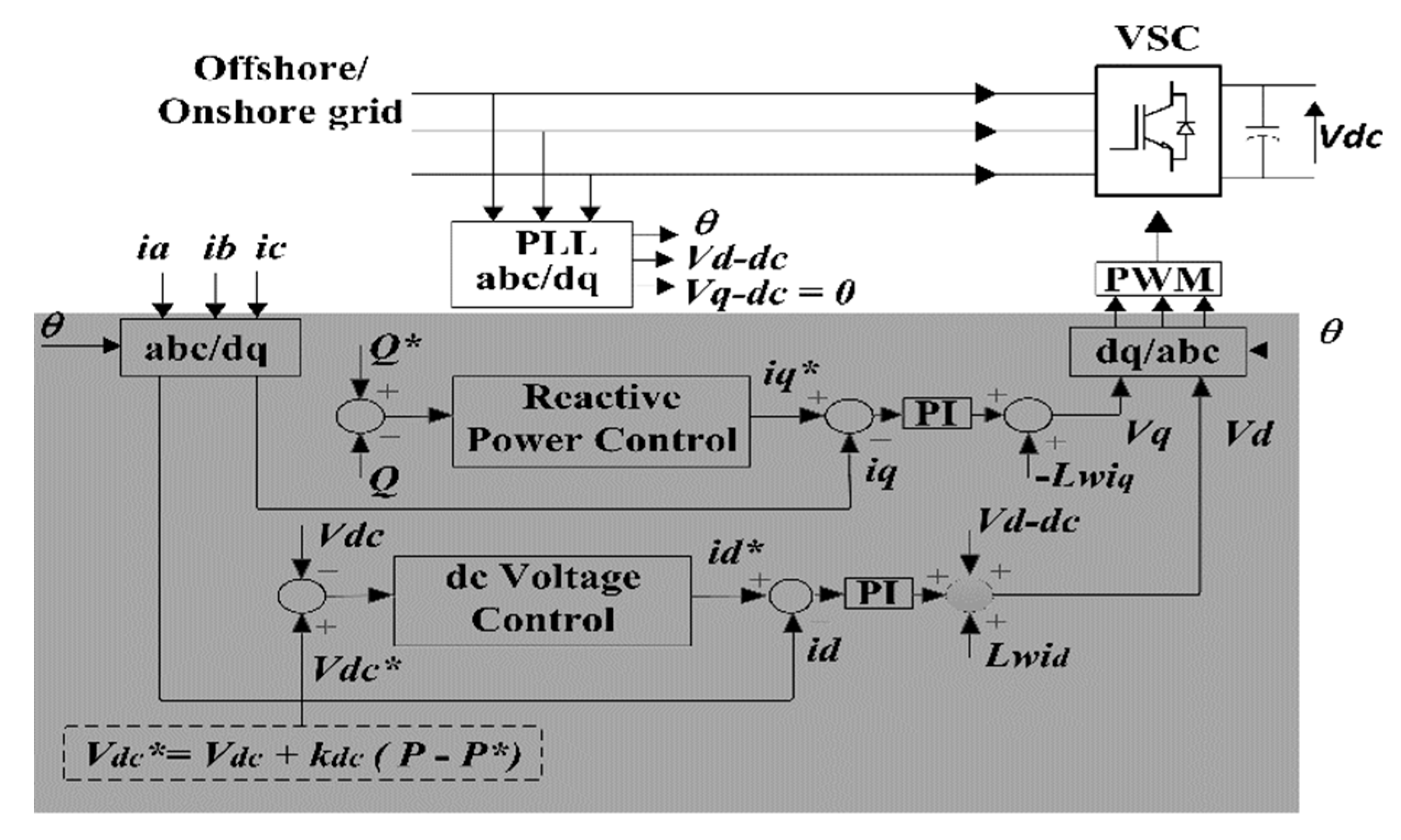

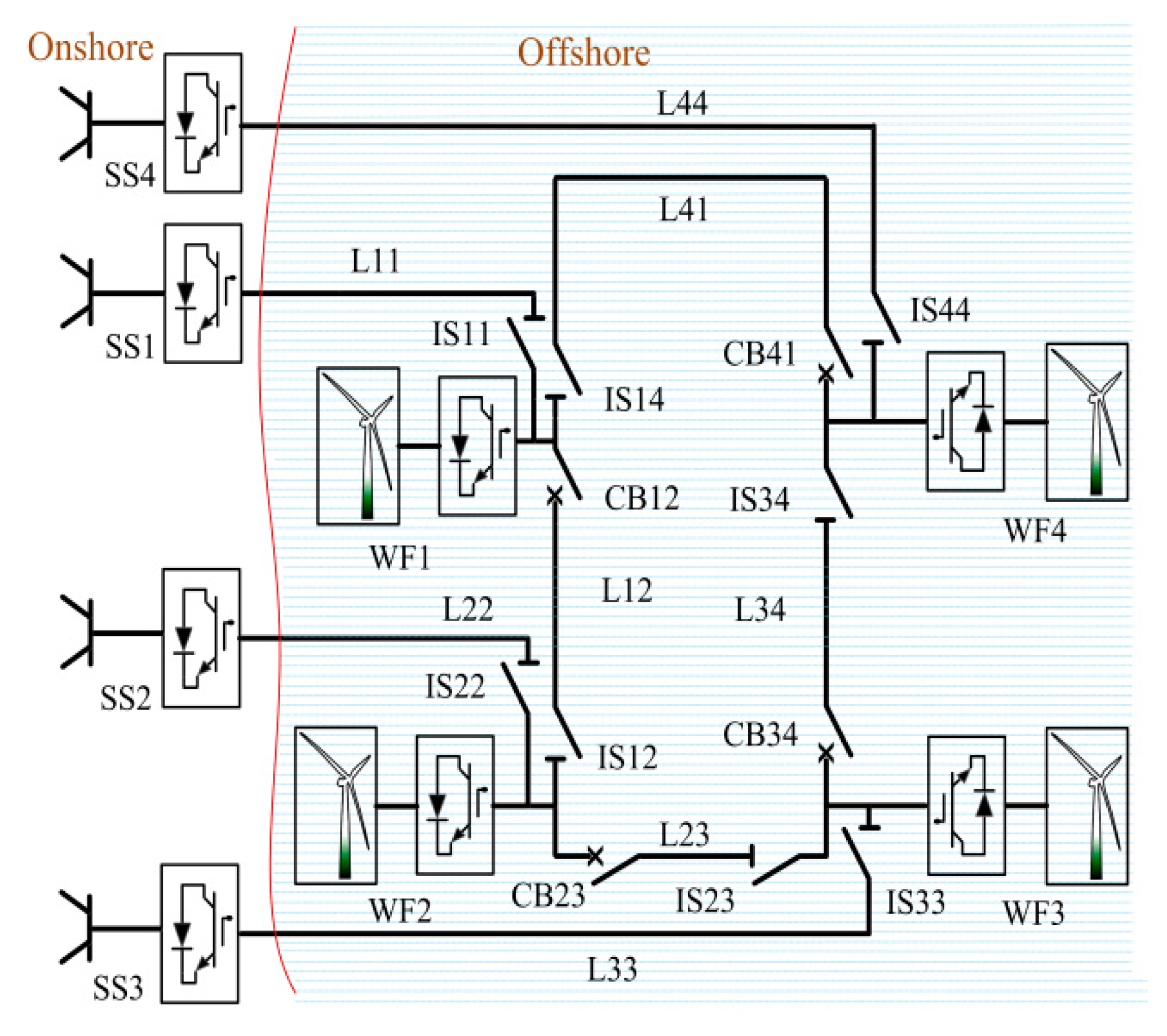
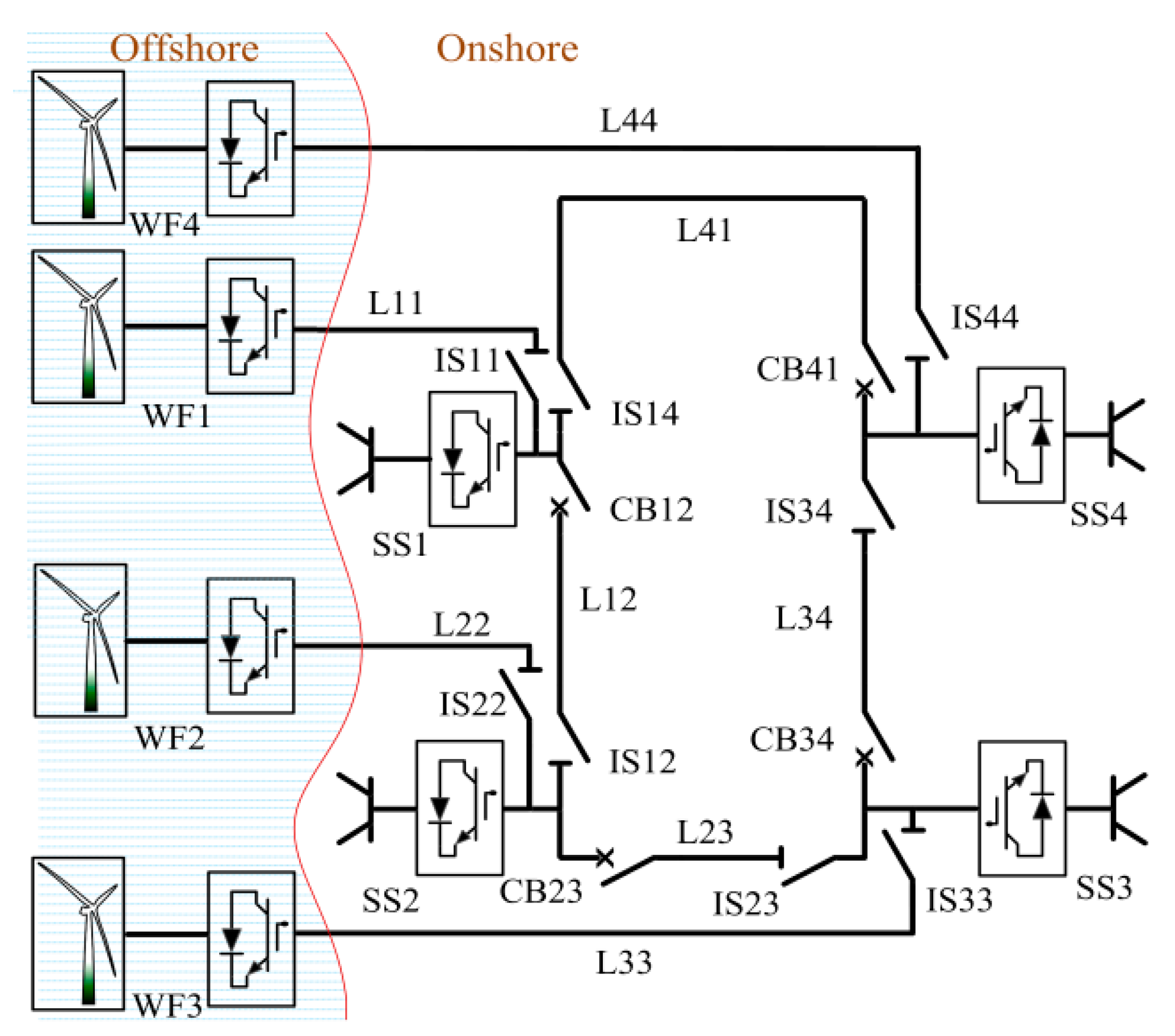

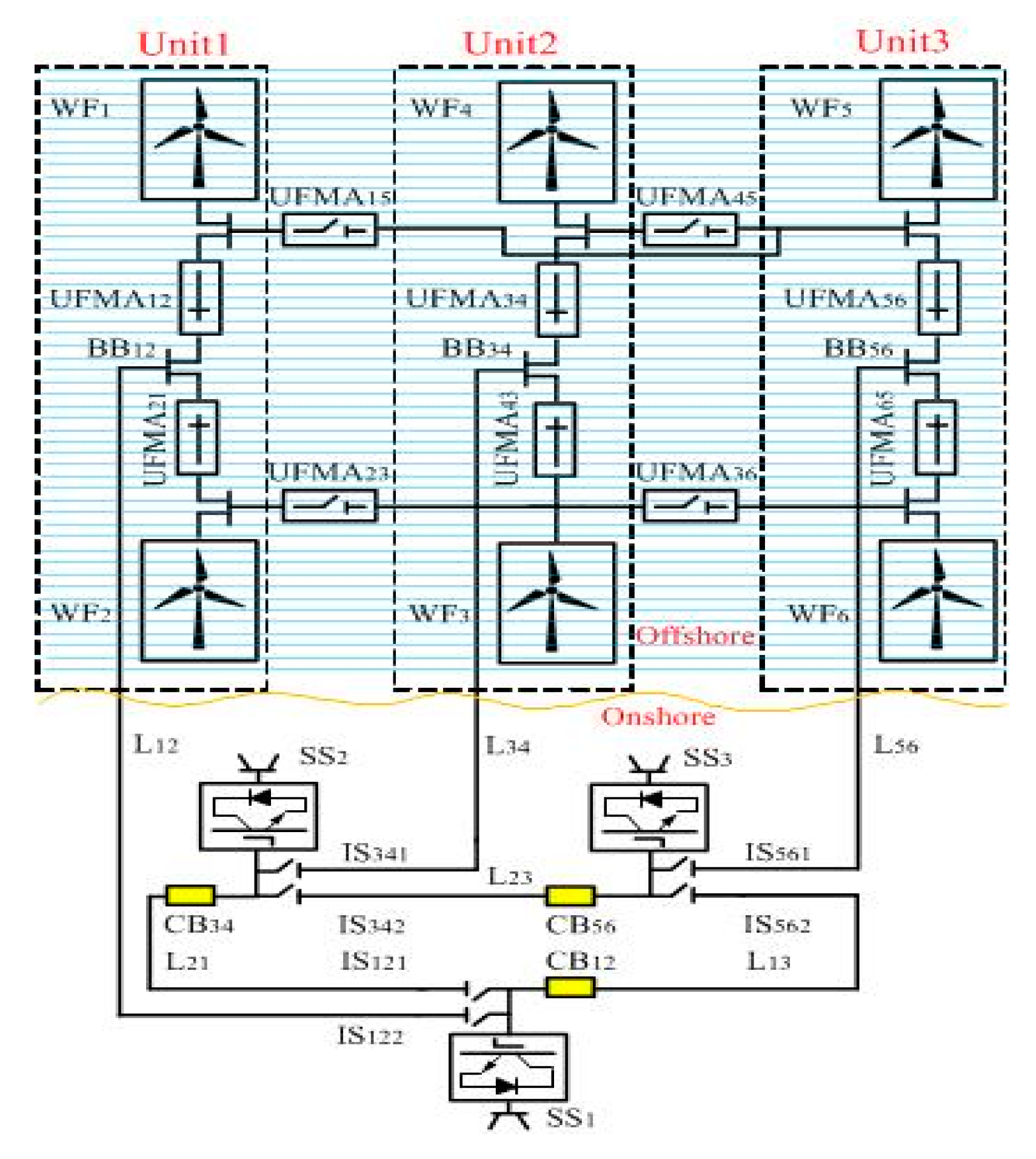
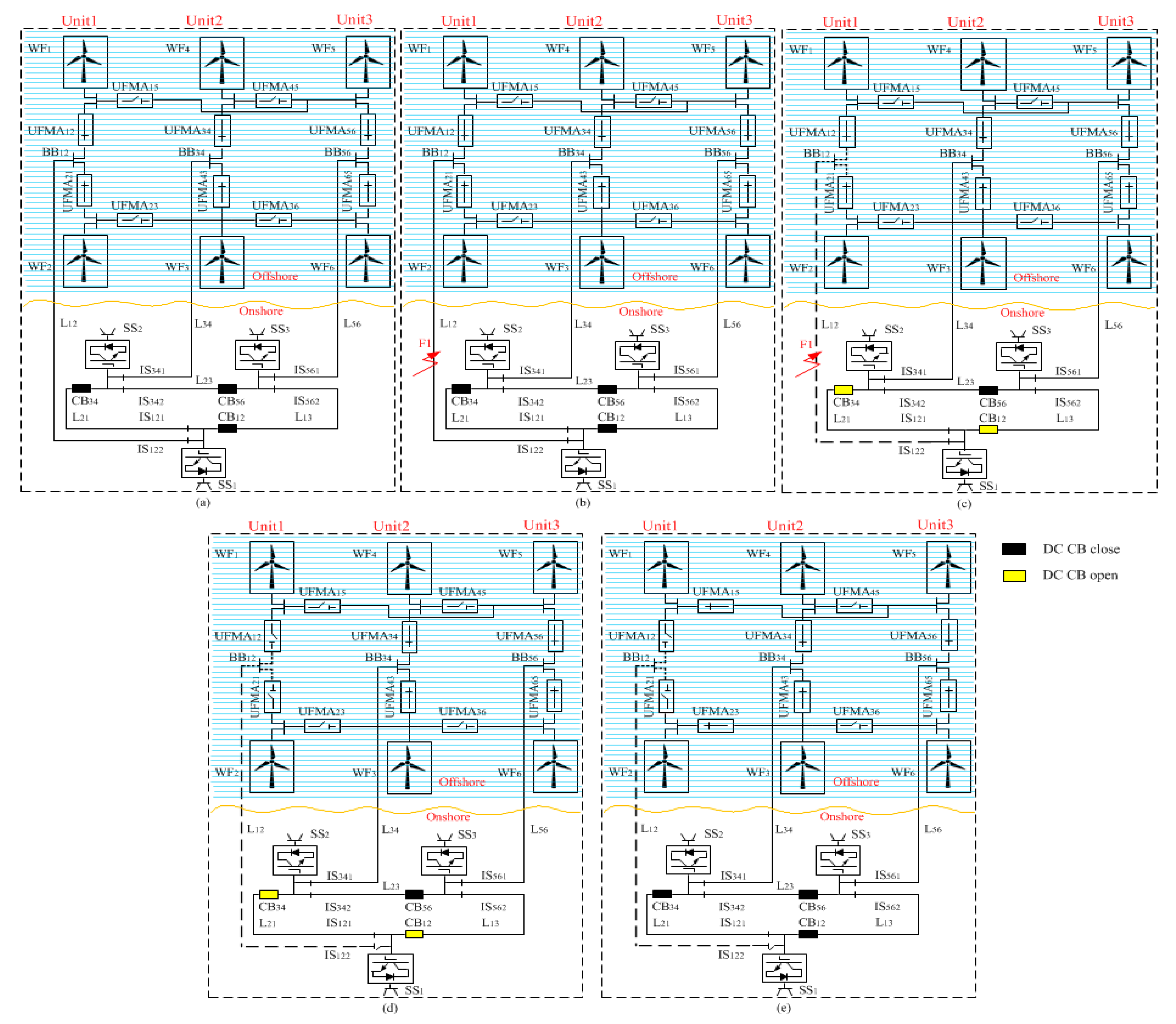
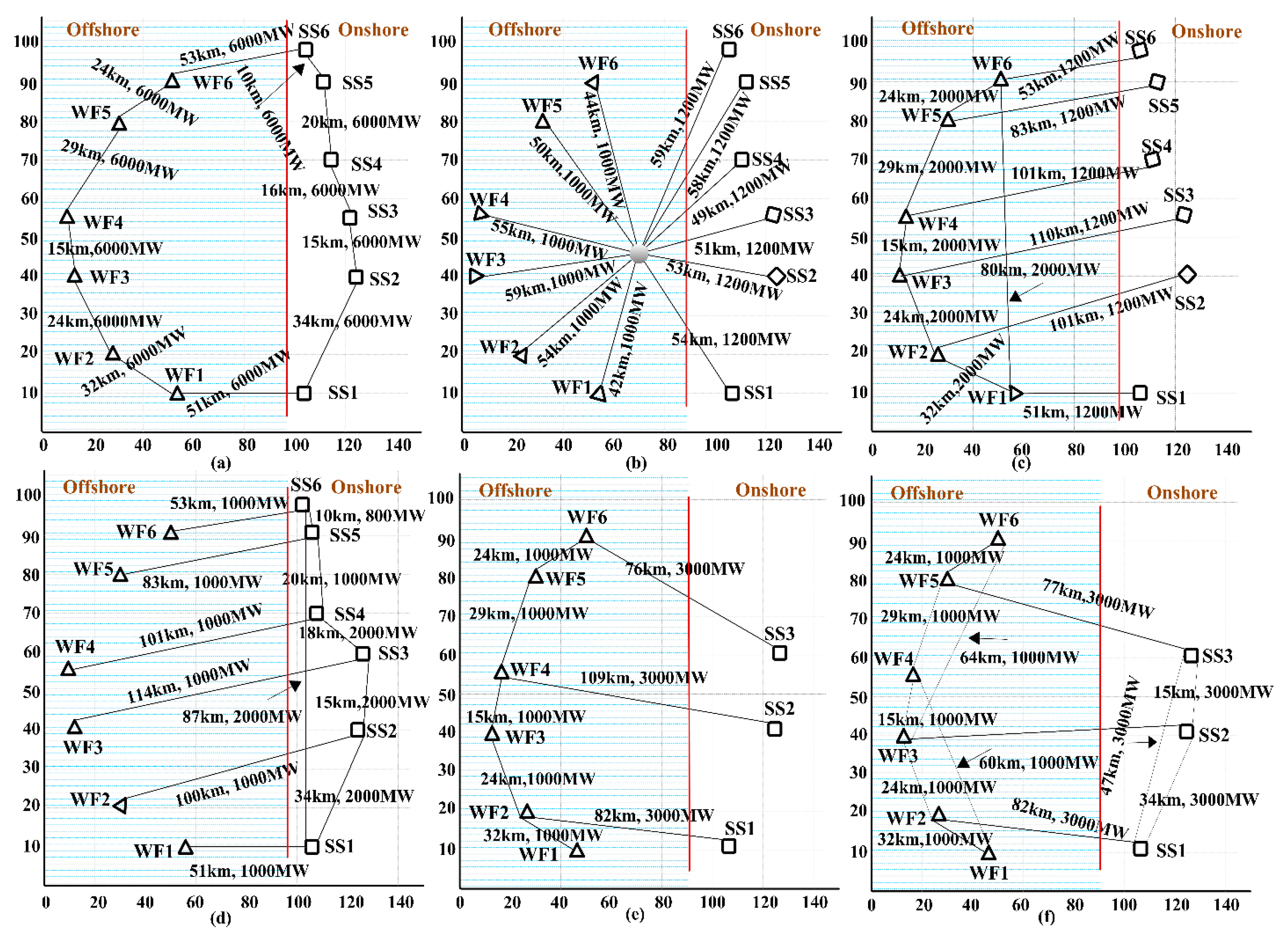
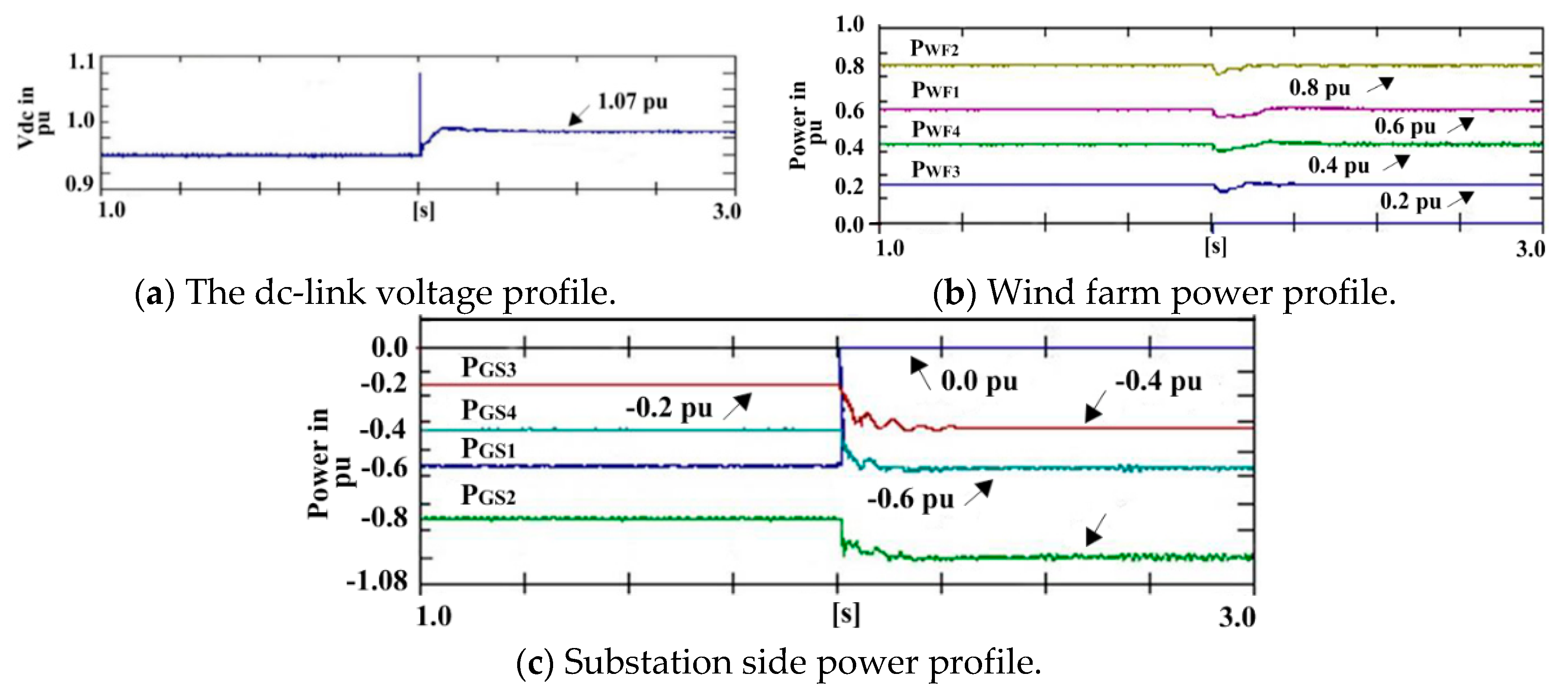

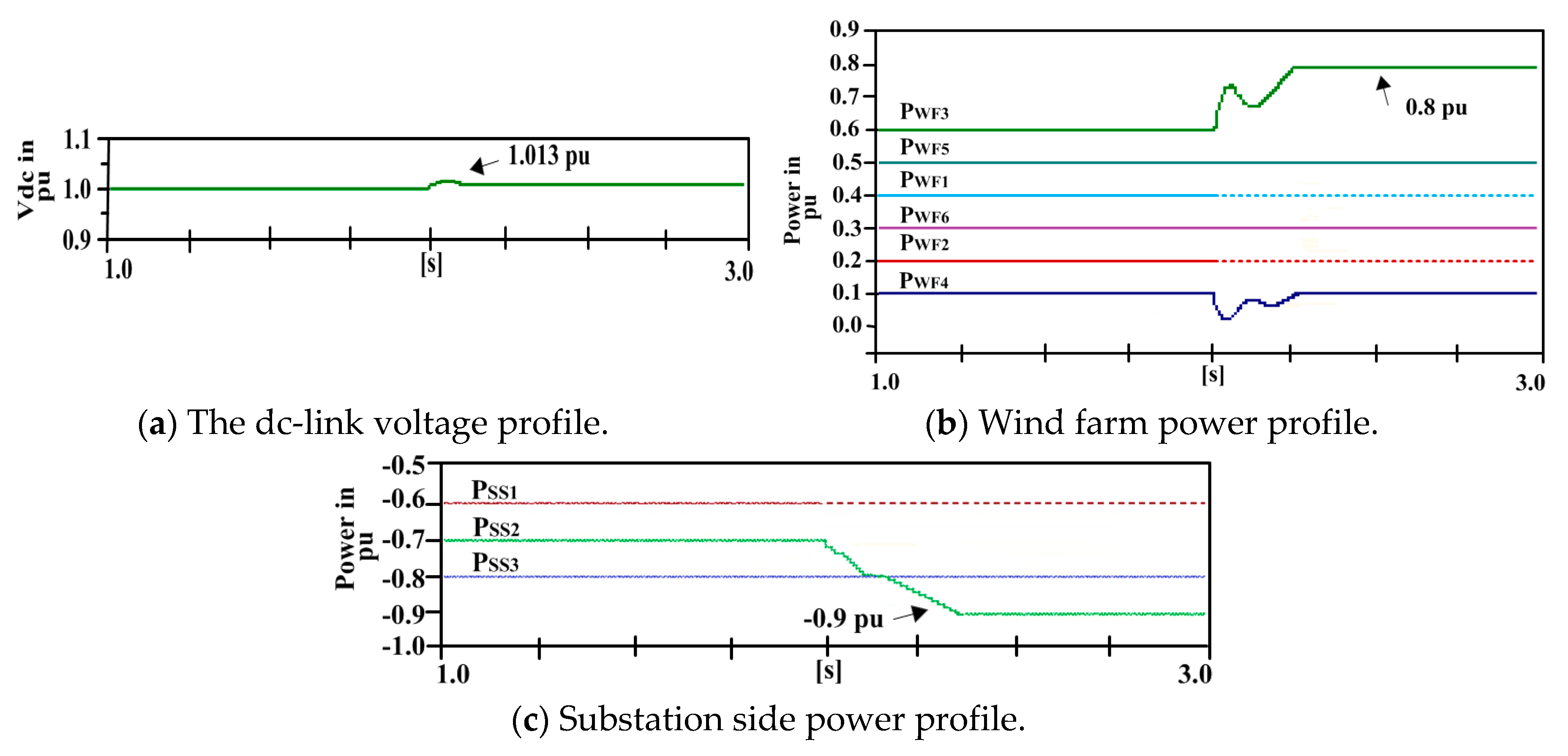
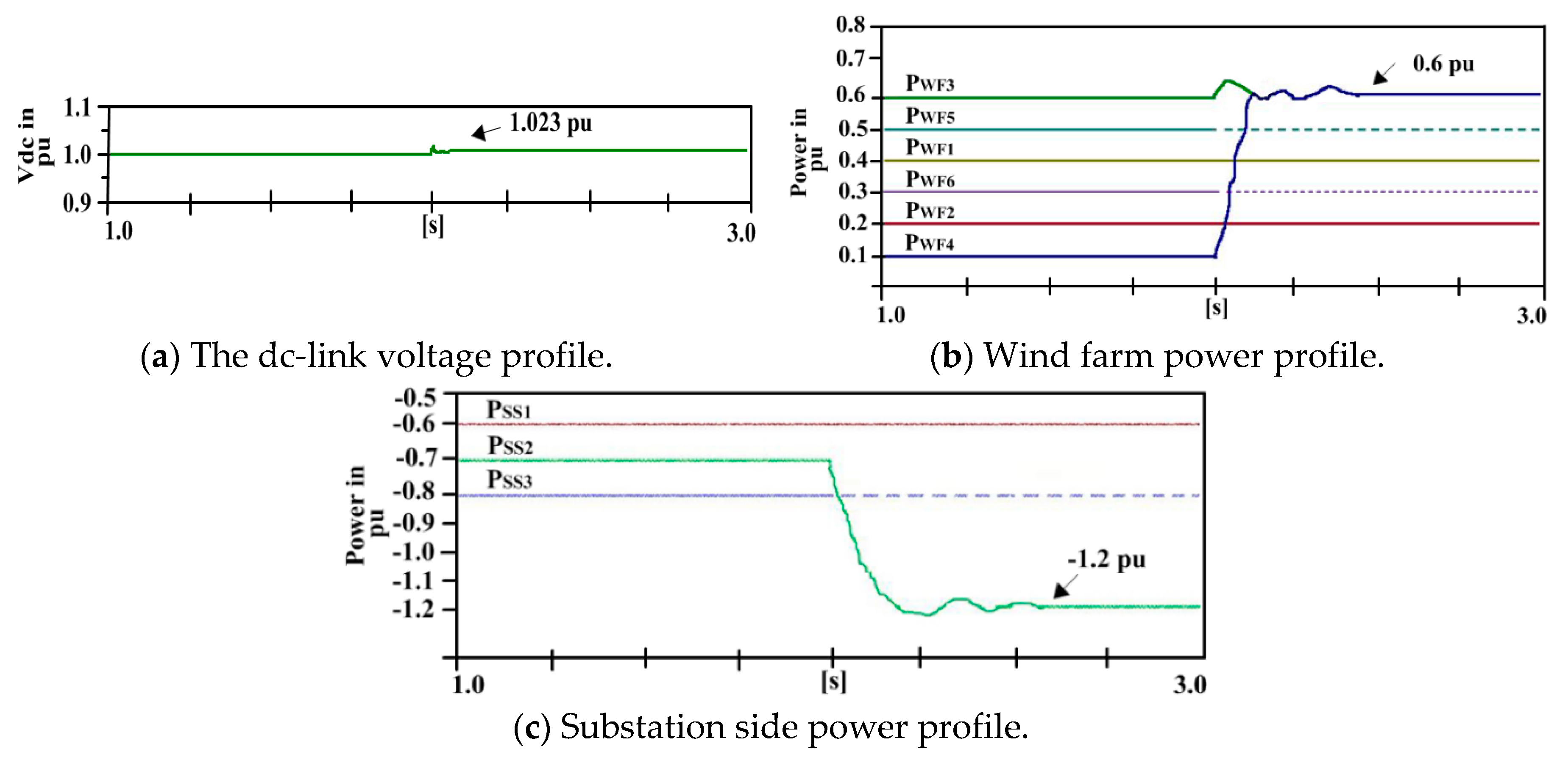

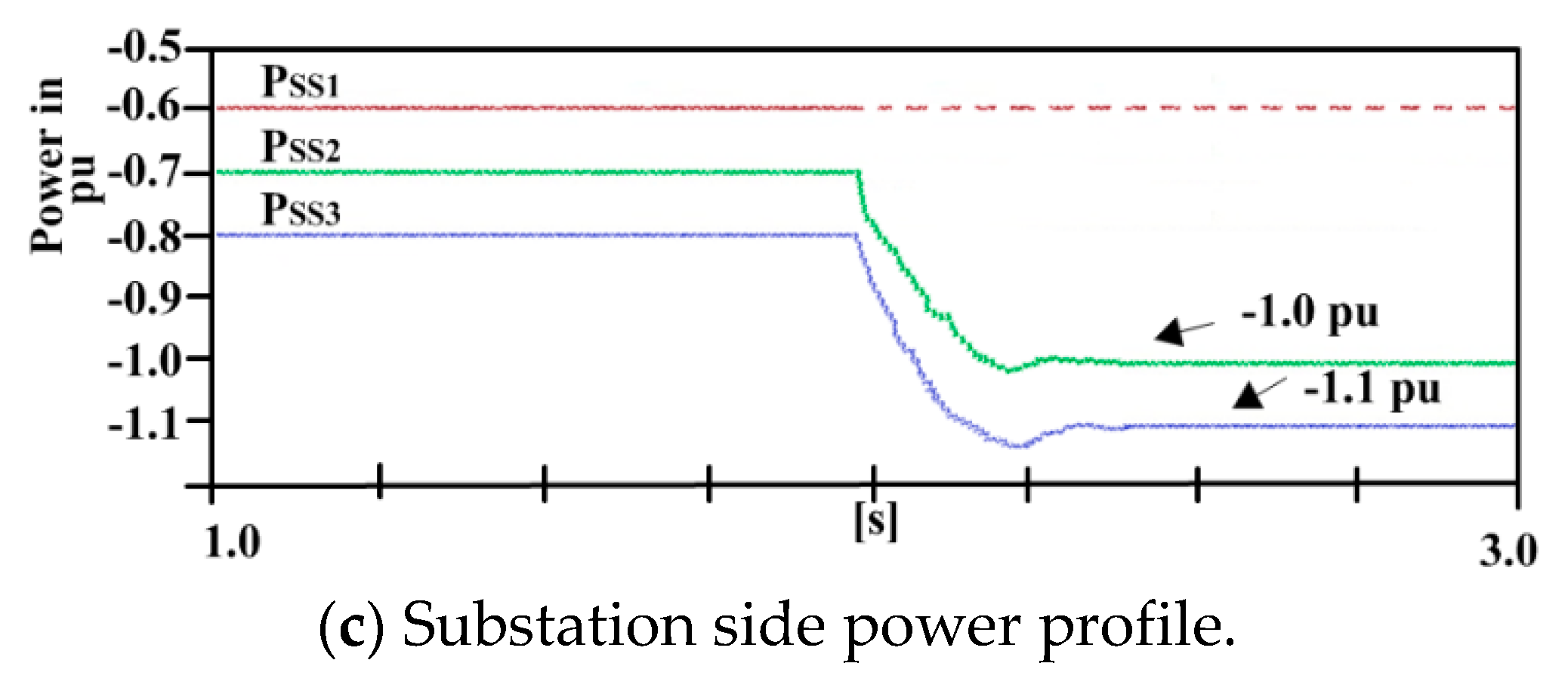
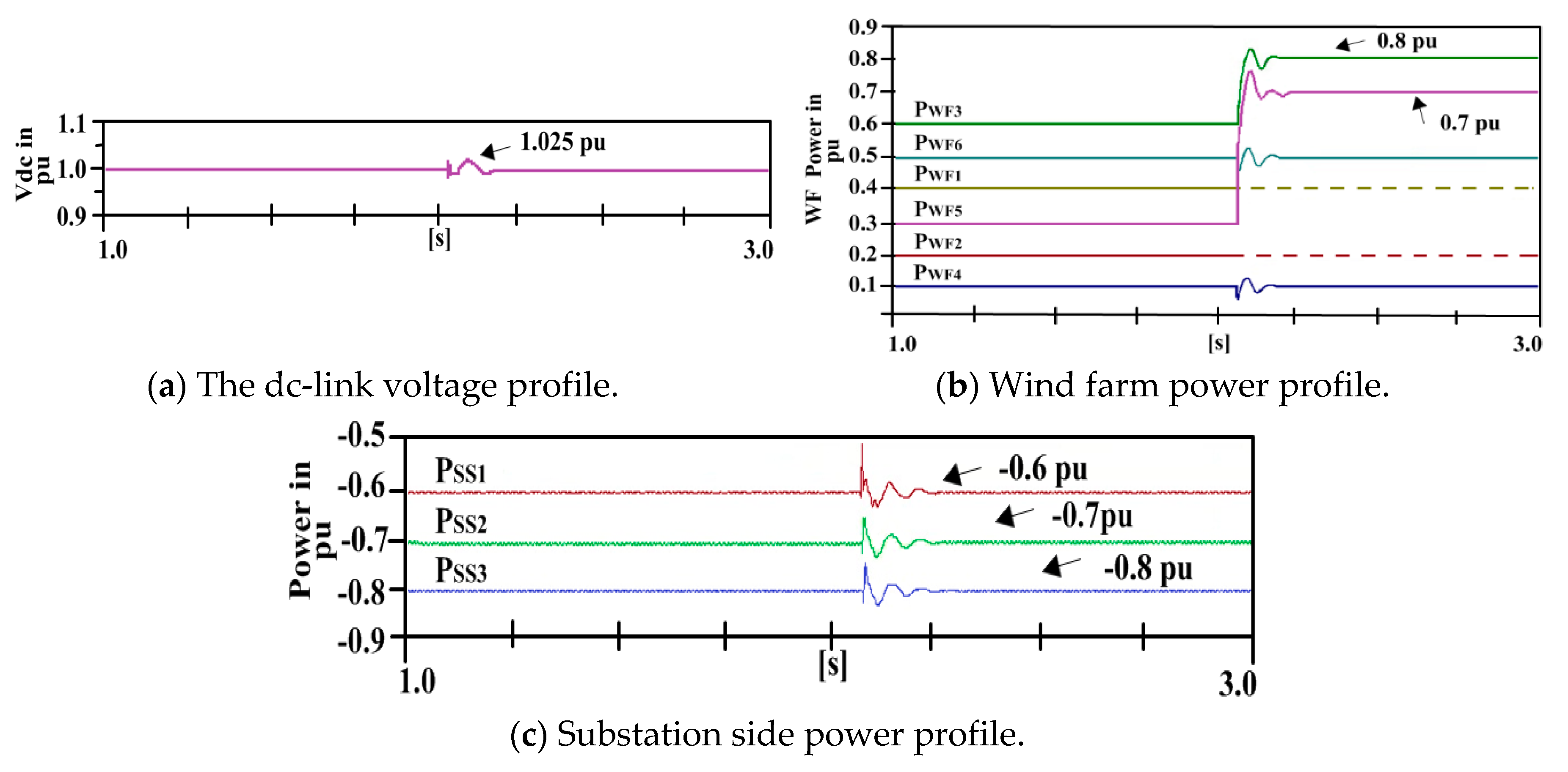
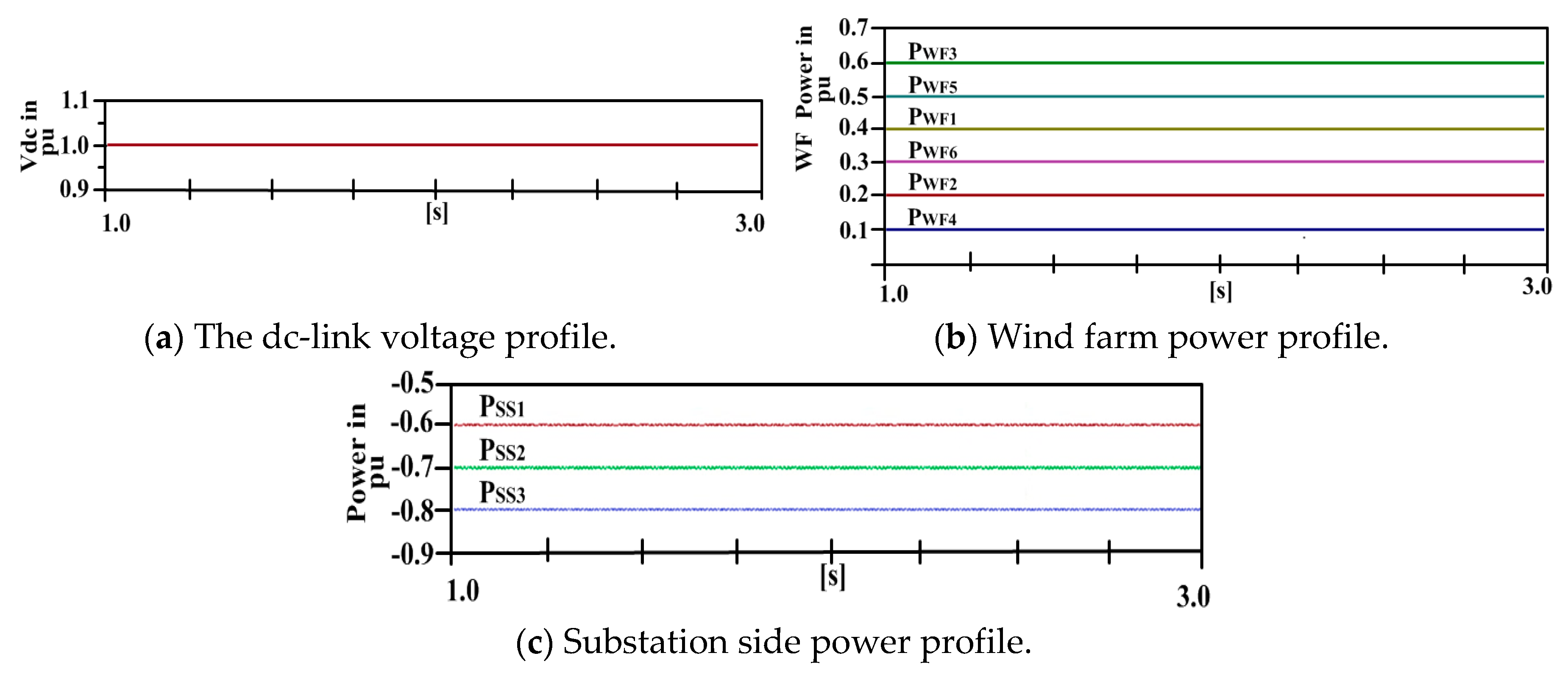
| DC Grid Specifications | ||
|---|---|---|
| Parameters | Values | |
| DC grid voltage | 400 kV | |
| Droop coefficients k1, k2, k3, k4, k5, k6 | 5, 7, 4, 5, 3, 6 | |
| Max. power of each VSC | 1000 MW | |
| Converter capacitance | 1400 µF | |
| Coupling inductance | 2.5 mH | |
| DC lines | Inductance | Resistance |
| All DC links (Lij) | 0.50 mH | 0.10 Ω |
| PI Control Parameters | ||
| PI controller | Ti | Kp |
| q-axis PI | 0.0067 | 0.48 |
| d-axis PI | 0.0067 | 0.48 |
| P controller | 0.0400 | 0.01 |
| WF ac voltage PI | 1.0000 | 1.00 |
| Wind Farm | Horizontal (km) | Vertical (km) | Sub Station | Horizontal (km) | Vertical (km) |
|---|---|---|---|---|---|
| WF1 | 50 | 10 | SS1 | 101 | 10 |
| WF2 | 20 | 20 | SS2 | 128 | 45 |
| WF3 | 10 | 35 | SS3 | 125 | 70 |
| WF4 | 11 | 60 | SS4 | 123 | 80 |
| WF5 | 30 | 82 | SS5 | 110 | 91 |
| WF6 | 50 | 92 | SS6 | 102 | 95 |
| Centre point for ST | 75 | 45 | |||
| Topology | No. of CBs | Rating of CBs (MW) | No. of Cables | Total Length of Cables (km) | Rating of Cables (MW) | No. of VSCs | Rating of VSCs (MW) | Utilization | |||||||
|---|---|---|---|---|---|---|---|---|---|---|---|---|---|---|---|
| WF | GS | WF | GS | WF | GS | WF | GS | WF | GS | WF | GS | ||||
| PPT | - | - | 6 | 531 | 400 | 6 | 6 | 400 | 400 | 100% | |||||
| GRT | 7 | 5 | 2400 | 2400 | 7 | 5 | 332 | 2400 | 2400 | 6 | 6 | 2400 | 2400 | 20–50% | |
| ST | 6 | 6 | 400 | 480 | 6 | 6 | 671 | 400 | 480 | 6 | 6 | 400 | 480 | 80–100% | |
| WFRT | Ring | 6 | - | 800 | - | 6 | - | 208 | 800 | - | 6 | - | 800 | - | 50% |
| Line | - | - | - | - | - | 6 | 519 | - | 480 | - | 6 | - | 480 | 80% | |
| Total | 12 | 727 | 12 | - | |||||||||||
| SSRT | Ring | - | 6 | - | 800 | - | 6 | 190 | - | 800 | - | 6 | - | 800 | 50% |
| Line | - | - | - | - | 6 | - | 519 | 400 | - | 6 | - | 400 | - | 80% | |
| Total | 12 | 709 | 12 | - | |||||||||||
| 2WF-1SST | - | 3 | - | 1200 | 5 | 3 | 403 | 800−400 | 1200 | 6 | 3 | 400 | 1200 | 67–100% | |
| 2WF-SSRT | - | 3 | - | 800 | 5 | 3 | 800−400 | 800 | 6 | 3 | 400 | 800 | 80–100% | ||
| Topology | No. of DCCB | No. of HVdc Link | Extra Offshore Substation | Flexibility | Stability | Redundancy | Comm | Remarks | |
|---|---|---|---|---|---|---|---|---|---|
| PPT | Zero | NWF = NSS | No | No | Yes | No | No | Single terminal, not flexible | |
| GRT | NWF + NSS | NWF + NSS | No | Excellent | Moderate | Excellent | Yes | Flexible but the dc-link have to be rated at full system’s power | |
| ST | WF side | NWF + NSS | NWF | Yes | Bad | Excellent | Moderate | No | The rating of dc circuits of GS-VSC and WF-VSC are equal. Fault in the central star node will collapse the system |
| SS side | Zero | NSS | No | Excellent | Bad | Moderate | No | ||
| Total | NWF + NSS | NWF + NSS | Yes | Moderate | Moderate | Moderate | No | ||
| SGRT | WF side | NWF + NSS | NWF | Yes | Bad | Excellent | Moderate | No | Full power rating dc-link required in the central ring. Moderately flexible and stable |
| SS side | Zero | NSS | No | Excellent | Bad | Moderate | No | ||
| Total | NWF + NSS | NWF + NSS | Yes | Moderate | Moderate | Moderate | No | ||
| WFRT | WF side | NWF | NWF | No | Excellent | Excellent | Excellent | Yes | Requires a number of DCCBs equal to WFs. Flexible on the WFs side. Poor stability during fault inside the GS-VSC. |
| SS side | Zero | NSS | No | Bad | Bad | Moderate | Yes | ||
| Total | NWF | NWF + NSS | No | Moderate | Moderate | Moderate | Yes | ||
| SSRT | WF side | Zero | NWF | No | Bad | Bad | Moderate | Yes | Good stability but poor redundancy and flexibility. Number of HVdc CB is equal to NSS |
| SS side | NSS | NSS | No | Excellent | Excellent | Excellent | Yes | ||
| Total | NSS | NWF + NSS | No | Moderate | Moderate | Moderate | Yes | ||
| 2WF-1SS | WF side | Zero | NWF | No | Moderate | Moderate | Moderate | Yes | The number of DCCB is half to WFs. Moderate flexibility and stability |
| SS side | NSS | NSS | No | Bad | Bad | Bad | Yes | ||
| Total | NSS | NWF + NSS | No | Moderate | Moderate | Moderate | Yes | ||
| WF-SSRT | WF side | Zero | NWF | No | Excellent | Excellent | Excellent | Yes | Excellent flexibility, stability, and redundancy with the same number of HVdc CB as in 2WF-1SS |
| SS side | NSS | NSS | No | Excellent | Excellent | Excellent | Yes | ||
| Total | NSS | NWF + NSS | No | Excellent | Excellent | Excellent | Yes |
© 2020 by the authors. Licensee MDPI, Basel, Switzerland. This article is an open access article distributed under the terms and conditions of the Creative Commons Attribution (CC BY) license (http://creativecommons.org/licenses/by/4.0/).
Share and Cite
Raza, A.; Younis, M.; Liu, Y.; Altalbe, A.; Rouzbehi, K.; Abbas, G. A Multi-Terminal HVdc Grid Topology Proposal for Offshore Wind Farms. Appl. Sci. 2020, 10, 1833. https://doi.org/10.3390/app10051833
Raza A, Younis M, Liu Y, Altalbe A, Rouzbehi K, Abbas G. A Multi-Terminal HVdc Grid Topology Proposal for Offshore Wind Farms. Applied Sciences. 2020; 10(5):1833. https://doi.org/10.3390/app10051833
Chicago/Turabian StyleRaza, Ali, Muhammad Younis, Yuchao Liu, Ali Altalbe, Kumars Rouzbehi, and Ghulam Abbas. 2020. "A Multi-Terminal HVdc Grid Topology Proposal for Offshore Wind Farms" Applied Sciences 10, no. 5: 1833. https://doi.org/10.3390/app10051833








